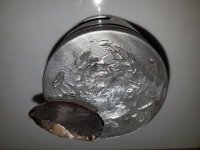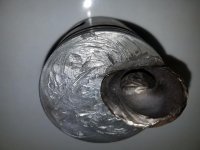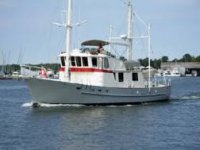Bob--
One of the problems with aircraft is that you cannot pull over to the side of the road to assess/fix a problem.
I'm glad the incident did not end catastrophically and since you lived to tell the story please share it with us.
Glad you asked Michael

. I don't remember the year, but it was 25-30 years ago. I was returning to Palo Alto from Burbank after visiting my then girlfriend in LA in a decrepit Cherokee 180 on Easter Sunday. I was over the Grapevine Pass (I5) level at about 6,000' altitude. The pass is about 2,500' feet or so, but there are some pretty high mountains on the west. With no warning, the Lycoming O360 engine started shaking violently and ceased producing almost all power. In hindsight, I should have shut it down as it's not unheard-of for engines to shake themselves off their mounts--in which case I wouldn't be writing this now--especially if the prop throws a blade, but I left it running (in a fashion).
I looked down and the obvious first choice for an off-airport landing was the freeway, but it was pretty busy and there wasn't a long, straight section. My second option was the frontage road, but it had no straight sections and I knew from training there are usually signs, wires and other obstructions near two-lane roads. I spotted a fairly straight dirt road, and felt comfortable with that having practiced emergency procedures in similar terrain (including some large power lines nearby). I did a normal left-hand pattern to the dirt road but overshot the base-to-final turn--which was fortuitous as I found out later there was a large 'sand trap' in the road--and aimed for a clearing just ahead (I remember looking around and, since it was spring the clearing and hills were covered in green grass and poppies in bloom, and thinking "well, if I don't make it they can just dig a hole here and throw me in it"). After I touched down I saw a large berm--buried gas line--but had just enough groundspeed to pull back on the yolk and lift the nose gear over the berm (lucky break# 2). Anyway, I made a decent approach and landing but relaxed just a little at the end and groundlooped about 45deg to the left.
I radioed ATC and let them know I made it down and they dispatched a CHP officer and a local deputy (the highway patrolman later told me I was talking pretty fast for a while). I was not too far from the little town of Gorman, which had a Greyhound stop but missed the last bus. The CHP got permission from his captain to give me a lift to a town about 20 miles away--forgot the name--which had a later bus. Somewhere in there, I made a call to my parents, who were having a little pool party with some family; when I told my mom what happened she fell in the pool!
As luck would have it (lucky break# 3) I'd landed in a county (I think) park called Paradise Valley or similar, and one of the rangers was an airframe & powerplant mechanic; after a week or so he made arrangement for a deputy friend to close the road temporarily and we loaded the plane on a flatbed, in one piece, and trucked it to a nearby airport called Quail Lake, with police escort! We pulled the engine and found that one of the sodium-filled exhaust valves had separated at the stem and blown pieces into the other three cylinders. We also found the engine had an incorrect camshaft for the engine; whether that caused or contributed to the valve failure is speculation. To this day, I wonder if I could have made Quail Lake if I'd known it was there, but I doubt it and would probably have ended up in the lake on the west side of the runway.
We hung the new engine and I flew around the airport for an hour or so to do the preliminary break-in on the engine, during which I got buzzed by an A6 Intruder! Turns out that area is an MOA--Military Operations Area--and is used for low-level military training. We even got buzzed by a couple Phantoms when we were loading the plane on the flatbed.
Looking back, it was a great adventure, but one that I really don't want to do again (I haven't flown in a few years, but often entertain thoughts of getting back in the cockpit before nature determines I can't).
Side story: When departing Burbank once--don't remember if it was before or after the 'incident'--there was a couple spit-polish green A10 Thunderbolts--known better as 'Warthogs'--sitting on the ramp near the FBO (they were probably doing an airshow demo nearby). Both had their canopies open and their air stairs extended--pre-September 11, of course--and I remember thinking "I wonder if they left the keys in those things."

 Hi Guest!
Hi Guest!

 smilie in place of the real @
smilie in place of the real @
 Pretty Please - add it to our Events forum(s) and add to the calendar! >>
Pretty Please - add it to our Events forum(s) and add to the calendar! >> 






